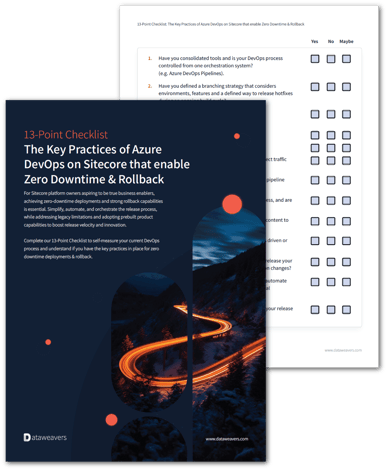Sitecore deployments: How to achieve parallel releases for uninterrupted Sitecore operations





Performing parallel releases in Sitecore application and infrastructure environments is like having multiple lanes on a highway. Just like how a highway with multiple lanes can handle a larger volume of traffic and allow vehicles to move faster, parallel releases allow multiple teams to work on the platform simultaneously without interfering with each other. Imagine a major highway only had one lane.
Parallel releasing ensures that the platform can be updated, improved, and optimized in a timely manner without causing downtime or affecting the user experience. It's like having a smooth and efficient traffic flow on a highway, where all vehicles can reach their destination quickly and without any major disruptions.
Getting ahead of your Sitecore platform
Sitecore Platform owners want to be seen as business enablers, but, many find it hard to get ahead of the platform. They have unreliable infrastructure that stifles innovation, and reckless releases that increase tech debt and cause digital teams to focus on maintaining the infrastructure rather than building valuable digital experiences.
To overcome these challenges, platform owners need flawless performance of their Sitecore platform and its environment and the ability to make decisions with velocity because they have a platform they can trust.
When it comes to innovation, digital teams must have the ability to make decisions with velocity. We first talked about proven CI/CD pipelines, and how to achieve zero downtime deployments. Another piece of the puzzle is ensuring parallel teams can release without bringing the platform down.
What does it mean to release in parallel?
Parallel release capability for teams managing and maintaining Sitecore infrastructure and applications is an important aspect of ensuring uninterrupted operation of the platform, while maximizing velocity. It allows multiple teams, both internal and Digital Agencies, to work on different parts of the CMS platform simultaneously and release changes without impacting the performance and stability of the platform.
Without this capability, teams are forced to wait for one team to finish their release before starting their own – leading to slow pace of development and change, ultimately slowing platform growth and innovation.
But, without a clear strategy and approach for Parallel releases, with the right checks and balances in place, the risk of causing downtime or negatively impacting the user experience increases as multiple teams release changes simultaneously without proper coordination.
Benefits of parallel release capability
A clear strategy for enabling parallel release capability gives digital teams – both development and marketing - the ability to work in tandem and release changes with minimal disruption to the platform. It allows them to accelerate their pace of development and marketing feature utilization, reduce time to market, and achieve business goals faster.
On a technical level some of the benefits include:
- Feature Based Development
- Feature flags
- Bug Fixes and Maintenance
- Stable and Experimental Branches
- Multiple Release Tracks
- Aligning with Customer Needs
Version control systems based on Git are commonly used to facilitate parallel development by allowing teams to manage and merge code changes effectively. Defining how branching strategies such as GitHub flow work with multiple teams with Continuous integration and continuous delivery (CI/CD) practices is essential to automate testing and deployment processes, making it easier to manage multiple Sitecore release streams.
Are your teams blocking one another?
Talking with digital teams that encompass development, infrastructure, front end, back end and users from the marketing teams – we know that there are several frustrations when teams are blocked by one another.
By not clearly defining a parallel development approach, the processes pose several risks for software development projects.
First and foremost, it can significantly slow down the development process. Without effective parallel processing, team members may have to wait for others to complete their tasks before they can proceed, leading to prolonged development cycles and delayed project timelines.
Less adaptive and iterative approach
The lack of parallel development can result in a less responsive and adaptive development environment. Teams may struggle to address issues and implement changes swiftly, hindering the project's ability to adapt to evolving requirements or respond to emerging challenges.
Lack of collaboration and communication
Teams working independently without parallel processes may find it challenging to integrate their work seamlessly, leading to integration issues and potential conflicts between different components or modules.
Quality assurance and testing procedures may be compromised.
If development and testing are not carried out concurrently at the feature level, bugs and issues may be identified late in the development lifecycle, making it more difficult and costly to address them. This can ultimately impact the overall quality of the software.
Slower release cycles
When changes can only be made one at a time, release cycles are slow and cumbersome – making it difficult for digital teams to respond quickly to changing business requirements and market demands.
Higher risk of errors
With out a clear approach to Parallel development, making changes to a live environment always carries risk. The risk of introducing errors or bugs, or dependencies on other teams increases.
Overall, not adopting a clear parallel development processing strategy increases the risk of project delays, reduces responsiveness to change, hampers collaboration, and compromises the quality of the final product. Embracing parallel development strategies helps mitigate these risks by fostering a more efficient, collaborative, and adaptive software development process.
How to enable parallel release capability in your Sitecore environment
A key step in ensuring stability and velocity in your Sitecore implementation is ensuring your team is enabled and has proper training of parallel development processes.
Training in parallel development, branching strategies and software release management typically covers a range of concepts, tools, and best practices to enable development teams to work on multiple releases simultaneously. The most important component here is defining a unified approach across all teams. Some key areas to be overviewed related to parallel development and software release management:
- Source Control Systems
- Release Management
- Continuous Integration/Continuous Deployment (CI/CD)
- Features by Branch
- Feature Flagging in production
- Consideration for Hotfix approach
- Automated testing
- Bug Tracking and Resolution
- Collaboration and Communication
- Risk Management
- Case Studies and Real-world Examples
Training in these areas can be obtained through various channels, including online courses, workshops, webinars, and certification programs. Many training platforms and organizations offer courses on version control systems, DevOps practices, and software release management.
It's also beneficial to gain hands-on experience by working on projects that involve parallel development and releases under the guidance of experienced mentors or trainers. This practical experience helps reinforce theoretical concepts and provides a deeper understanding of the challenges and solutions in real-world scenarios.
While training is clearly important, its also possible to acquire at a platform level pre-built experience that is codified. Meaning that, getting this right can be bootstrapped.
At Dataweavers one of our key values is bringing this experience in in our codified platform approach thus ensuring Sitecore teams get the benefit of velocity and proven practice quickly.
How we can help you get started
Check out our 13 Key Practice Checklist for Sitecore, to self-measure where you land in your current DevOps process:





